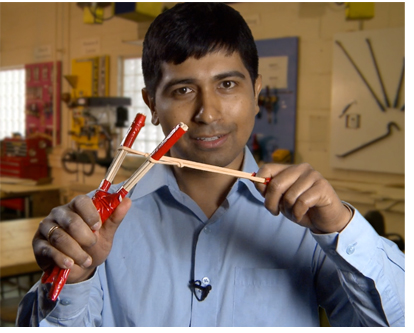| |
 Many MIT students spend time sailing along the Charles River, but very few understand the complex physics involved in the sport they love! This was the case of Emma Ferris, an Officer in the U.S. Navy, who completed her Masters in Mechanical Engineering at MIT in June of 2017. She used her love of sailing and long experience on the water to create a lesson that will enable students to identify the forces acting on a sailboat and understand how the combination of these forces results in moving the boat forward. This lesson is beautifully filmed on Boston’s Charles River, with several demonstrations by Emma herself of the forces involved. Students will be involved in activities requiring them to develop free body diagrams that support their solutions to the questions posed in the video. There is also an option for students to design their own sailboats as part of this lesson. You can watch the lesson here. Many MIT students spend time sailing along the Charles River, but very few understand the complex physics involved in the sport they love! This was the case of Emma Ferris, an Officer in the U.S. Navy, who completed her Masters in Mechanical Engineering at MIT in June of 2017. She used her love of sailing and long experience on the water to create a lesson that will enable students to identify the forces acting on a sailboat and understand how the combination of these forces results in moving the boat forward. This lesson is beautifully filmed on Boston’s Charles River, with several demonstrations by Emma herself of the forces involved. Students will be involved in activities requiring them to develop free body diagrams that support their solutions to the questions posed in the video. There is also an option for students to design their own sailboats as part of this lesson. You can watch the lesson here.
 Have you ever wondered why elastic bands finally loose their elasticity or snap under certain conditions? The focus of this new lesson is to introduce high school students to the concept of Elasticity, one of the fundamental concepts in understanding the physics of deformation in solids. According to the lessons’s creator, Sourish Chakravarty, a post doctoral associate at MIT, this lesson has four main learning objectives: (1) To understand the essential concept of Elasticity and be able to distinguish simple solid objects based on degree and extent of their elastic properties; (2) To appreciate the utility of the elastic force vs. deformation curve through experiments; (3) To be aware of potential sources of error present in such experiments and identify corrective measures; and (4) To appreciate the relevance of Elasticity in practical applications. This lesson involves students in several active, hands-on learning challenges, such as performing an experiment to generate the force vs deformation curve for a rubber band by gradually extending it vertically through the addition of weights. Watch the lesson here. Have you ever wondered why elastic bands finally loose their elasticity or snap under certain conditions? The focus of this new lesson is to introduce high school students to the concept of Elasticity, one of the fundamental concepts in understanding the physics of deformation in solids. According to the lessons’s creator, Sourish Chakravarty, a post doctoral associate at MIT, this lesson has four main learning objectives: (1) To understand the essential concept of Elasticity and be able to distinguish simple solid objects based on degree and extent of their elastic properties; (2) To appreciate the utility of the elastic force vs. deformation curve through experiments; (3) To be aware of potential sources of error present in such experiments and identify corrective measures; and (4) To appreciate the relevance of Elasticity in practical applications. This lesson involves students in several active, hands-on learning challenges, such as performing an experiment to generate the force vs deformation curve for a rubber band by gradually extending it vertically through the addition of weights. Watch the lesson here.
 Two Boston Latin High School physics teachers, Aaron Osowiecki and Jesse Southwick, have developed an introductory physics lesson that encourages students to investigate real forces while learning how to develop visuals to represent those forces. Rather than modeling forces in abstract situations, the lesson challenges students to develop free body diagrams that accurately describe the forces acting on them as they participate in the lesson activities. This lesson is designed to confront the following student misconceptions: 1) That the scale measures the force of gravity. The scale actually reads the normal force pushed up onto you by the scale; and 2) That the normal force always equals the force of gravity. In fact, they are not always equal, as students will see. Both teachers are authors of “Energizing Physics,” a progressive physics curriculum used at Boston Latin High School and other schools throughout the country. Watch their lesson here. Two Boston Latin High School physics teachers, Aaron Osowiecki and Jesse Southwick, have developed an introductory physics lesson that encourages students to investigate real forces while learning how to develop visuals to represent those forces. Rather than modeling forces in abstract situations, the lesson challenges students to develop free body diagrams that accurately describe the forces acting on them as they participate in the lesson activities. This lesson is designed to confront the following student misconceptions: 1) That the scale measures the force of gravity. The scale actually reads the normal force pushed up onto you by the scale; and 2) That the normal force always equals the force of gravity. In fact, they are not always equal, as students will see. Both teachers are authors of “Energizing Physics,” a progressive physics curriculum used at Boston Latin High School and other schools throughout the country. Watch their lesson here.

|
|
|
 Zhiming Darren Tan is the Senior Specialist for Physics in the Curriculum Planning and Development Division of the Singapore Ministry of Education. In 2014, he received his PhD. in Theorestical Physics at Oxford University. As an outgrowth of his deep passion for everything science, Darren has taken on the persona of “Science Samurai”, and in this role has delivered much entertaining and informative science education - both in person and through online videos. His BLOSSOMS lesson, “The Physics of Boomerangs,” explores the mysterious physics behind boomerangs and other rapidly spinning objects. Students get to make and throw their own boomerangs during active learning breaks between video segments! Follow him on Twitter @Science Samurai and watch his BLOSSOMS lesson here. Zhiming Darren Tan is the Senior Specialist for Physics in the Curriculum Planning and Development Division of the Singapore Ministry of Education. In 2014, he received his PhD. in Theorestical Physics at Oxford University. As an outgrowth of his deep passion for everything science, Darren has taken on the persona of “Science Samurai”, and in this role has delivered much entertaining and informative science education - both in person and through online videos. His BLOSSOMS lesson, “The Physics of Boomerangs,” explores the mysterious physics behind boomerangs and other rapidly spinning objects. Students get to make and throw their own boomerangs during active learning breaks between video segments! Follow him on Twitter @Science Samurai and watch his BLOSSOMS lesson here.
|
|
 By Richard Larson, Head P. I. of MIT BLOSSOMS By Richard Larson, Head P. I. of MIT BLOSSOMS
Each year, it seems, the pressure for a young person to get into a good college or university becomes greater. Underlying much of the pressure, almost hysteria in some American households, is a four-letter acronym – STEM (science, technology, engineering and mathematics).
Think of the largest, fastest-growing U.S. companies – Apple, Google, Amazon and Facebook – all hi-tech STEM companies. But STEM talents are also valued by Disney, American Airlines, Uber and even the New England Patriots. Most traditional trades – auto mechanics, electricians, HVAC mechanics and the like – now require STEM knowledge. STEM job growth exceeds that of any other major sector of the economy, and salaries are good and rising.
 There’s a STEM-mania among today's young people, boosted by their parents, to acquire a STEM degree and then have a challenging and lucrative career. STEM-mania not only afflicts many in the United States but also those in other countries. Educators everywhere are examining how they educate their young people in STEM, and many are not satisfied. The United Kingdom is consulting China, China is looking to the U.S., and U.S. parents are increasingly enthralled with Russian mathematics. There’s a STEM-mania among today's young people, boosted by their parents, to acquire a STEM degree and then have a challenging and lucrative career. STEM-mania not only afflicts many in the United States but also those in other countries. Educators everywhere are examining how they educate their young people in STEM, and many are not satisfied. The United Kingdom is consulting China, China is looking to the U.S., and U.S. parents are increasingly enthralled with Russian mathematics.
(Read entire article here.)
|
|
|